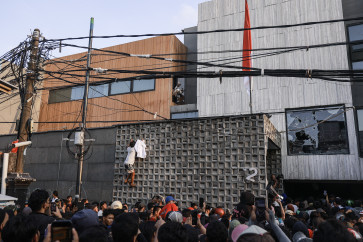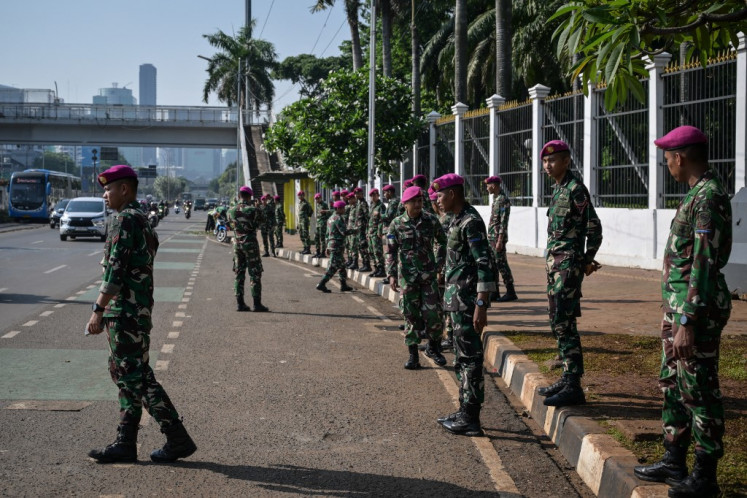Popular Reads
Top Results
Can't find what you're looking for?
View all search resultsPopular Reads
Top Results
Can't find what you're looking for?
View all search resultsAn astronaut, Czech artists & the Yali Mek in Papua
Down to earth: The couple introduced an American astronaut, Leroy Chiao (in space suit), to meet the Yali Mek
Change text size
Gift Premium Articles
to Anyone
Down to earth: The couple introduced an American astronaut, Leroy Chiao (in space suit), to meet the Yali Mek.
Czech photographer and painter Barbora Šlapetová and sculptor Lukáš Rittstein have captured the slow shift toward 'modernization' for the Yali Mek through photos, sculpture and by even introducing an astronaut to the tribe, which lives in a remote part of Papua.
The journey of Šlapetová and Rittstein started when the couple decided to fulfill a childhood dream to travel the world after living under a communist regime.
'Because our borders were closed by the communists during our younger times, we dreamed of going as far as we could; not only over land, but traveling through culture and time,' Šlapetová said. 'So that's why we wanted to go to as far as a 'stone age' time.'
Their choice took them to Papua. 'From the visual information we had gathered, we wanted to see the reality. And we fell in love with it since the first time we entered the land,' Šlapetová said during a recent visit to Jakarta.
Šlapetová and Rittstein first came to Papua in 1997, traveling through the province to look for tribes that could show how people 'from the stone age' could live today.
At work: Šlapetová and Rittstein first came to Papua in 1997, traveling through the province to look for tribes that could show how people 'from the stone age' could live today.
Welcome wagon: The pair's exploration led them to the Yali Mek tribe in Kosarek Village, about 35 miles southeast of Wamena.
The exploration led them to the Yali Mek tribe in Kosarek Village, about 35 miles southeast of Wamena.
'We spent 14 days with some tribes before having a deep interaction with the Yali Mek. We came to the conclusion that the Yali Mek were the best, with their great imagination ' untouched by civilization,' she said.
The Yali Mek live in the province's highlands, which meant that the pair had to take a missionary plane followed by a long walk to reach their location.
After getting permission from every family of the tribe, Šlapetová then started to bring out her camera. Šlapetová took pictures of the men who wore penis gourds (koteka) and topless women holding their kids inside wooden huts with roofs made of tree bark or palm leaves.
Thoughtful: After getting permission from every family of the tribe, Šlapetová then started to bring out her camera.
Hunting: Šlapetová showed how the men, with bows and carved arrowheads, hunted animals such as pigs for food.
In other photos, Šlapetová showed how the men, with bows and carved arrowheads, hunted animals such as pigs for food.
She also wanted to make her photos look like paintings. In 2003, she started to rearrange the images, combining the photos with items found in the world that she was closer to.
Later, Šlapetová started to use a 'magic box' made from glass to create experimental photographs.
'It came naturally, because I started to feel the spirits behind them. You couldn't have it in a documentary picture and you didn't have time to paint them. So it was very easy and helpful to make it more like a painting [by using the magic box],' she said.
Meanwhile, Rittstein captured interactions with the Yali Mek by making casts of the tribe's heroes.
'It was a big adventure for them,' Rittstein said. 'They called it [the cast] white, hard mud. As I did my work, it started to become an attraction and everyone wanted to be part of it.'
The people asked him to show them his results during the next visit.
The wish came true. In 2008, two years later, Rittstein brought the casts from Prague. 'They received it with a big celebration. We witnessed the mix of traditional ritual with a contemporary art happening,' he said.
Rittstein and Šlapetová also organized an art installation in Prague that featured Šlapetová's photos and 10 sculptures of Rittstein's interactions with the Yali Mek.
Their visits to the village ' which sometimes lasted for two to three months, before the pair had children ' gave them opportunities to take documentary pictures and to be involved in two-way conversations, aided by translators.
'We talked about love, we talked about our beliefs, we talked about the world and many things,' she said.
On one night, they were talking about stars and Šlapetová asked what stars meant for the Yali Mek. 'They said that they are the eyes of people that travel into the skies, looking back and making lights while the people are sleeping.'
Šlapetová then told them that out there, there were people who went there and saw the stars themselves. 'And they were curious about them.'
Later, another wish of the tribesmen came true. The couple brought an American astronaut, Leroy Chiao, to meet the Yali Mek.
Spaceman: Chiao, a mission specialist on three Space Shuttle missions and a former commander of the International Space Station, compared his experiences in reaching the sky with the Papuans.
In images captured by Šlapetová, Chiao, a mission specialist on three Space Shuttle missions and a former commander of the International Space Station, compared his experiences in reaching the sky with the Papuans.
Looking at the pictures, it is evident that the Yali Mek have changed. 'The chief, he's completely changed. He now wears clothes, uniforms, and even has a cell phone,' Šlapetová said.
She said that she realized that their visits to the village had to some extent affect the tribe, as it was their first encounter with art.
Rittstein said that he and Šlapetová wanted to show the Yali Mek that there was more to life than just the material world. 'There's also art, and they can play with it.'
Their stories of Papua are told through the books Why the Night Is Black and Do Not Come Any Closer, published in Prague. They also preserved the stories in a video recording that has been screened to the Yali.
The artists are currently in Papua to give an Indonesian version of the books to young Papuans who attend school to help them understand the almost forgotten tales of their ancestors.
'They want to see everything they have done with us during the long period of communication,' Šlapetová said.
' Photos courtesy of Barbora Šlapetová















